I have been deeply involved in the cryptocurrency field for 10 years. Six years ago, I resolutely decided to resign and devote myself to this wave of digital finance. From having nothing to financial freedom, my life trajectory was completely changed one night five years ago. That night, a senior's heartfelt words, like a morning bell and evening drum, enlightened me, clarified my positioning, and deeply understood the eight stages that currency investors must go through. I use these stages as a mirror to constantly reflect on myself, and finally regained everything I had lost! Perhaps in the eyes of the world, retail investors are always the weaker side, like fish on a chopping board.
If you are standing in front of the door of the currency circle and hesitating, I sincerely hope that my sharing can light a lamp for you. I think I have a certain ability to summarize and express, and I hope my experience and insights can provide you with some valuable references. Back to the point, let's go straight to the topic!
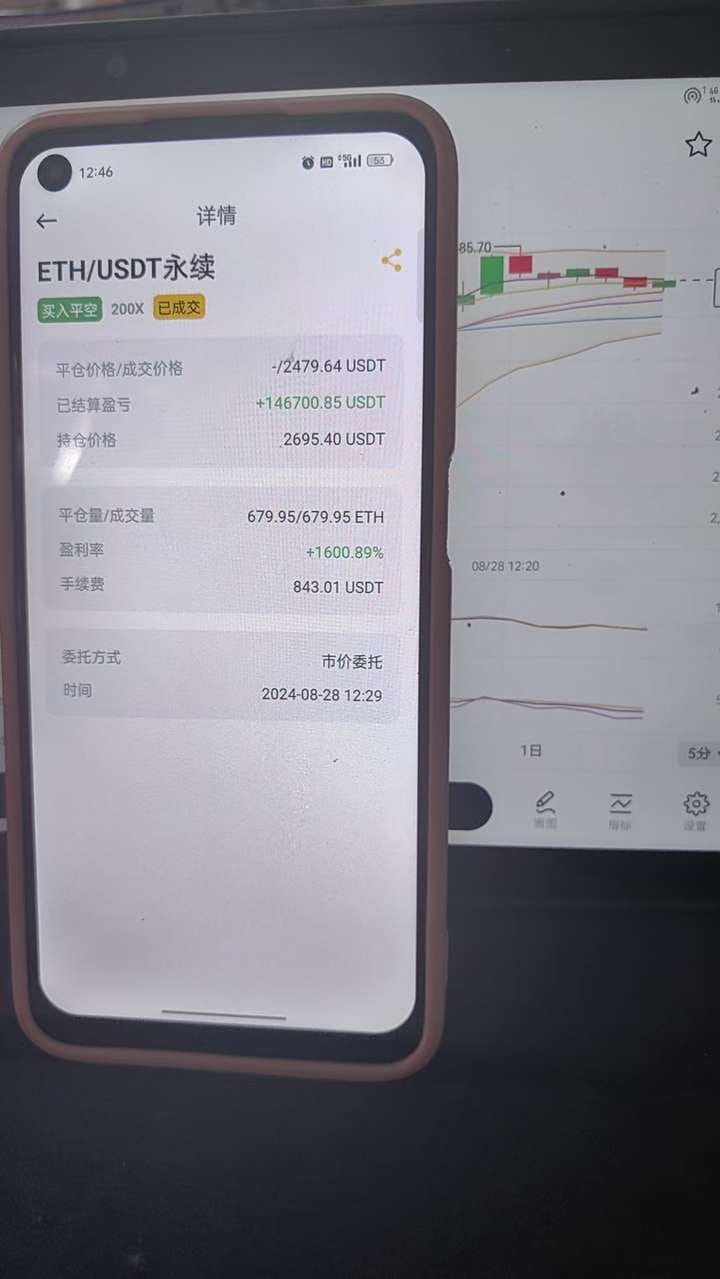
On the journey of currency trading, when you face a difficult selling moment, you might as well ask yourself: If your analysis is accurate, why is the market going in the opposite direction? There is only one answer - that is your judgment is wrong, because the market is always right, it never makes mistakes!
In addition to excellent technology, I also strictly follow the following 8 iron laws:
1. Don't rush to get on the bus: When you hear that others have made money, you may feel itchy, but don't rush in. You have to know some basic things first, understand what currency trading is all about, and then consider investing money in it.
2. Be careful not to chase the rise and fall: Don't follow others blindly, and don't blindly follow others to buy. Maybe it's too late when you know someone is buying. It's better to wait patiently for a good opportunity to start.
3. Don't put all your money on one thing: Don't put all your eggs in one basket. You have to diversify your investment and buy several different ones, so that the risk will be dispersed.
4. You have to set a bottom line for yourself: Think about how much loss you can bear, don't throw all your money into it for a gamble. Set a stop loss point, and stop quickly when you lose to a certain extent to protect your principal.
5. Study more, don't mess around: Learn more about the currency circle, such as looking at the basic situation of a certain currency, and listening to what professional players say. Don't just listen to those unreliable rumors and inside information.
6. Don't be too greedy: Seeing that you have made some money, you want to make more, but you may end up with nothing, and you won't have a penny left. Take out some of the profits in time, don't always think about making more.
7. Don't be led by emotions: The market fluctuates too much, don't sell in a hurry just because others are as anxious as ants on a hot pot, and don't blindly follow the rise just because others are buying.
8. Time is your friend: Don't rush, time will help you. Don't think about getting rich overnight, be patient, take your time, be steady, and make money slowly.
The above 8 principles are the mistakes I have made repeatedly in the past. Now I share them with you. You must carefully study them, constantly practice them, and achieve unity of knowledge and action. I hope to help currency friends avoid a few years of detours.
So how to do well in currency trading? Once a person enters the financial market, it is difficult to turn back. If you are still confused about your losses and plan to use currency trading as a second career in the future, you must know the 'simplest EMA strategy'. Reading, understanding, and comprehending it will definitely save you a lot of detours. These are all personal experiences and feelings, and it is recommended to collect them and repeatedly study them!
What should a normal market include?

Generally, the entire market is divided into two parts, main and auxiliary, or you can put the main chart alone, depending on personal habits.
Let's look at the main chart first:
What indicators are generally used in the main chart?
I personally prefer to use the weighted moving average EMA, but some people also use MA.
What is the difference between the moving average MA and the weighted moving average EMA?
A simple explanation of MA is to average the stock prices of several days and then connect them into a line.
For example, the 5-day moving average: average the prices from the first day to the fifth day, average the prices from the second day to the sixth day, average the prices from the third day to the seventh day, and so on. Connect these values into a line to get the 5-day moving average.
How to understand it?
If the current price is above the 5-day moving average, it means that the market's purchasing power has been relatively enhanced in these five days, and vice versa, it means that the market's purchasing power has been continuously declining in these five days.
5 days is too short, what if it is replaced with a 120-day moving average?
That is to say, if the market price is above the 120-day moving average, it means that the purchasing power in these 120 days is continuously rising? What signal is this? Short-term purchases may be oscillating, but long-term purchases will form a trend, so the 120-day moving average has the role of judging medium and long-term trends.
If the price crosses above the 120-day moving average from below the 120-day moving average and successfully stabilizes, it means that there will be a wave of medium-short-term or long-term rising market next. This is the meaning of the moving average.
What is EMA then?
It is an algorithm based on MA. As for how to calculate it, it is more complicated. Its characteristic is that it increases the sensitivity of MA, so that the moving average can follow the adjustment when the short-term k-line changes drastically.
As shown in the figure, 12345 are EMA5, 20, 40, 60, and 120-day lines respectively.
The reason why I personally choose EMA is because it is smoother than MA, looks pleasing to the eye, and can increase the accuracy of judgment. The difference is not very big, and the latter is recommended for short-term trading.
The relationship between the moving average and the price: The price is like a dog running wild, and the moving average is like a rope. When the dog runs too far, there will be a pulling force between the rope and the dog.
However, moving averages only care about price and not the combination of volume, so the dealer will use moving averages to create various long and short traps. Remember: talking about price without volume is just a bluff.
Take a look at the perfect arrangement of these moving averages:

The situation where the moving average plays a supporting role.

The situation where the moving average plays a suppressing role.
Feel it carefully.
How to use moving averages to help us better judge?
Some indicators extended from moving averages, such as:
What do golden cross, death cross, price support, price pressure, golden spider, and dead spider mean respectively?
Golden cross: The intersection formed by the short-term moving average crossing above the long-term moving average, which has a supporting effect on the price in the short term. As shown in the picture:
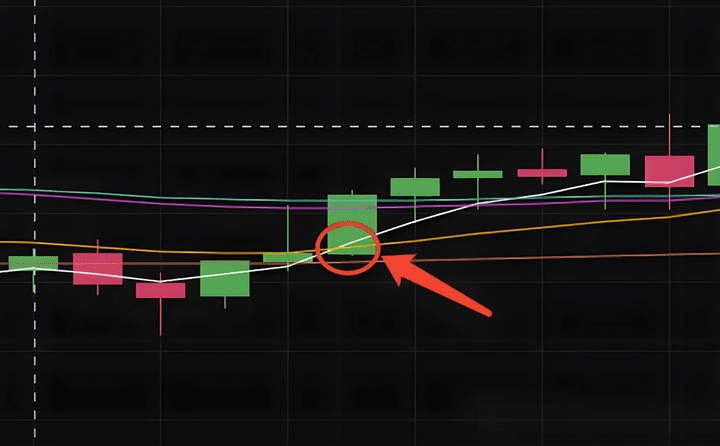
There are two golden crosses in the picture: the intersection formed by the 5-day moving average crossing above the 10-day moving average, and the golden cross formed by the 5-day line crossing above the 20-day line. The price rose successfully in a short period of time.
5-day golden cross description: People who bought within 5 days are willing to use an average price higher than the 10-day average to chase the rise, so the short-term demand is greater than the supply, and the price rises as a matter of course.

The intersection formed by the 5-day moving average crossing below the 10-day moving average in the picture is called a death cross, which has a suppressive effect on the price in the short term.
Golden cross and death cross have a role in judging the future trend to a certain extent.
But it also has a lag. If it is a short-term moving average, it is even more limited.
How to increase its power?
Multiple crossovers occur simultaneously: golden spider and dead spider.

The picture shows a typical dead spider: the 5-day line crosses below the 10-day and 20-day moving averages, and the 10-day line crosses below the 20-day line, forming a shape like a six-legged spider. This is a strong bearish warning.

Conversely. The shape formed by the 5-day line crossing above the 10-day line, the 5-day line crossing above the 20-day line, and the 10-day line crossing above the 20-day line is called the golden spider. The appearance of the golden spider indicates the arrival of the bull market.
The appearance of a spider often indicates the trend of the market in the next period of time, because it involves three cycles at the same time. As for how long the trend will last, it depends on the moving average of what cycle is involved.
Similarly, as long as the moving average crosses, it has a delay. How to increase its stability and persistence?
So further extension: price support and price pressure.
Price support: The triangle formed by the three intersection points of the 5-day moving average crossing above the 10-day moving average, the 10-day moving average crossing above the 20-day moving average, and the 5-day moving average crossing above the 20-day moving average, which has a supporting effect on the price in the future. As shown in the picture:
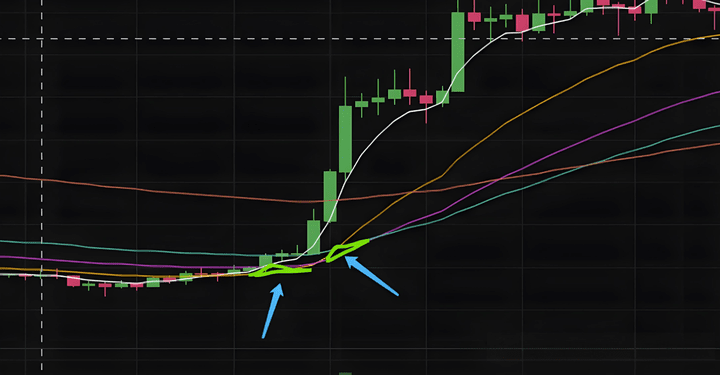
Not only formed a price support, but also formed a double price support. The facts prove that a wave of rising market for up to three months appeared later.

Price pressure: The triangular area formed by the intersection of the 5-day moving average crossing below the 10-day moving average, the 5-day line crossing below the 20-day line, and the 10-day line crossing below the 20-day line, has a suppressive effect on the price in the future.
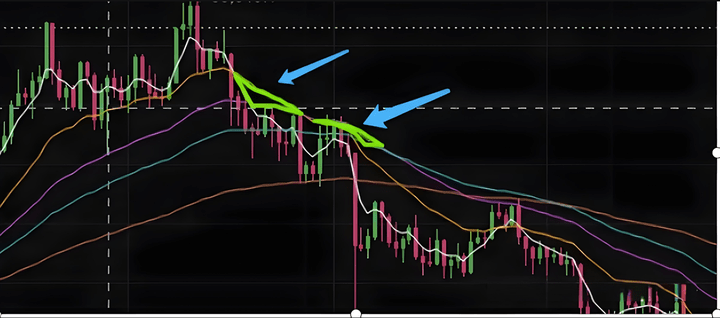
It is also a double price pressure pattern. Under this price pressure, the price fell for a whole year.

So generally, the beginning of a period of market often starts with the appearance of price support or price pressure patterns. The stability of the two price support or price pressure patterns is higher. When this pattern appears, bulls can enter the market on dips, and vice versa.
Note: Except for sideways oscillating markets.
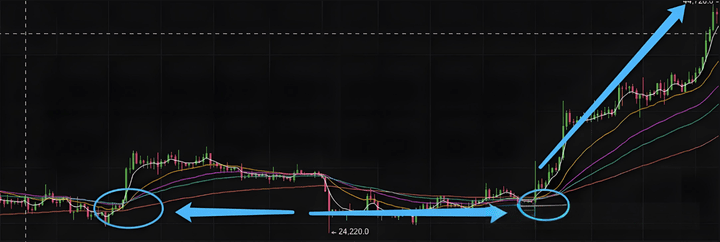
Let's take a look at the picture above and think about a question: How did the two horizontal double price supports appear? Why does this kind of market appear?
You need to reflect and explore it yourself! This article will be shared here.
The above are all 10 years of trading experience in currency trading. I have experienced a lot of bumps. These are heartfelt words after thorough understanding. I hope it will be helpful to everyone. Yanan's products must be high-quality products. There are beautiful women in the currency circle, peerless and independent, with a soul in the way, and a technique for controlling currency!
Even the most diligent fisherman will not go out fishing in the stormy season, but will carefully protect his fishing boat. This season will always pass, and a sunny day will always come! Follow me, I will teach you how to fish and give you fish. The door to the currency circle is always open. If you follow the trend, you can have a smooth life. Collect it and keep it in mind!